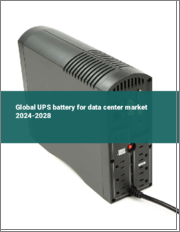
|
시장보고서
상품코드
1738079
UPS 배터리 시장 규모, 점유율, 성장 분석 : 정격별, 제품 유형별, 배터리 유형별, 용도별, 지역별 - 산업 예측(2025-2032년) 예측UPS Battery Market Size, Share, and Growth Analysis, By Rating (5KVA, 5-<50KVA), By Product Type (Off-Line/Standby, Line-Interactive), By Battery Type, By Application, By Region - Industry Forecast 2025-2032 |
||||||
UPS 배터리 세계 시장 규모는 2023년에 114억 달러로 평가되었으며, 2024년 131억 4,000만 달러에서 2032년에는 410억 6,000만 달러로 성장하고, 예측 기간(2025-2032년) 동안 CAGR 15.3%로 성장할 전망입니다.
환경적으로 지속가능한 UPS 배터리 기술에 대한 수요가 급증하고 있는 것은 소비자들의 환경 보호에 대한 관심이 높아지고 있음을 보여줍니다. 이 시장을 형성하는 주요 촉진요인으로는 재활용 가능한 재료, 에너지 효율적인 제조 공정, 지속가능한 사용 후 제품 관리 방법의 혁신 등이 있습니다. 또한, 재생에너지원의 확대와 전기자동차 인프라는 UPS 배터리의 필요성을 더욱 부추기고 있습니다. 많은 지역에서 전력망의 노후화와 자연재해로 인한 불안정한 전력 공급으로 인해 다운타임을 방지하기 위해 신뢰할 수 있는 UPS 시스템에 대한 의존도가 높아지고 있습니다. 동시에, 생산 기술의 발전으로 규모의 경제가 확대되고 생산능력이 확대되면서 리튬이온 배터리의 가격이 하락했습니다. 이러한 가격 하락으로 인해 리튬 이온 UPS 시스템은 기존 납산 옵션에 비해 경쟁력이 높아져 다양한 산업 분야의 수요를 촉진하고 전체 시장 성장에 기여하고 있습니다.
목차
소개
- 조사 목적
- 조사 범위
- 정의
조사 방법
- 정보 조달
- 2차와 1차 데이터 방법
- 시장 규모 예측
- 시장 가정과 제한
주요 요약
- 세계 시장 전망
- 공급과 수요 동향 분석
- 부문별 기회 분석
시장 역학과 전망
- 시장 개요
- 시장 규모
- 시장 역학
- 성장 촉진요인과 기회
- 성장 억제요인과 과제
- Porters 분석
주요 시장 인사이트
- 핵심성공요인
- 경쟁 정도
- 주요 투자 기회
- 시장 생태계
- 시장 매력 지수(2024년)
- PESTEL 분석
- 거시경제 지표
- 밸류체인 분석
- 가격 분석
UPS 배터리 시장 규모 : 정격별 & CAGR(2025-2032년)
- 시장 개요
- 5KVA
- 5-50KVA
- 50-200KVA
- 200 KVA 이상
UPS 배터리 시장 규모 : 제품 유형별 & CAGR(2025-2032년)
- 시장 개요
- 오프라인/스탠바이
- 라인 인터랙티브
- 온라인/더블 컨버전
UPS 배터리 시장 규모 : 배터리 유형별 & CAGR(2025-2032년)
- 시장 개요
- 리튬이온 UPS 배터리
- 납축 UPS 배터리
- 니켈 카드뮴 UPS 배터리
- 기타
UPS 배터리 시장 규모 : 용도별 & CAGR(2025-2032년)
- 시장 개요
- 통신
- 데이터센터와 IT 인프라
- 헬스케어
- 제조와 산업 공정
- 금융기관
- 군과 방위
- 기타
UPS 배터리 시장 규모 & CAGR(2025-2032년)
- 북미
- 미국
- 캐나다
- 유럽
- 독일
- 스페인
- 프랑스
- 영국
- 이탈리아
- 기타 유럽
- 아시아태평양
- 중국
- 인도
- 일본
- 한국
- 기타 아시아태평양
- 라틴아메리카
- 브라질
- 기타 라틴아메리카
- 중동 및 아프리카
- GCC 국가
- 남아프리카공화국
- 기타 중동 및 아프리카
경쟁 정보
- 상위 5개사의 비교
- 주요 기업의 시장 포지셔닝(2024년)
- 주요 시장 기업이 채용한 전략
- 최근의 시장 동향
- 기업의 시장 점유율 분석(2024년)
- 주요 기업 개요
- 기업 상세
- 제품 포트폴리오 분석
- 기업 부문별 점유율 분석
- 매출 전년비 비교(2022-2024년)
주요 기업 개요
- Schneider Electric(France)
- Eaton Corporation PLC(Ireland)
- Exide Industries Limited(India)
- GS Yuasa International Ltd.(Japan)
- East Penn Manufacturing Company(USA)
- EnerSys(USA)
- Delta Electronics, Inc.(Taiwan)
- ABB Ltd.(Switzerland)
- Emerson Electric Co.(USA)
- Vision Group(China)
- Amara Raja Energy & Mobility(India)
- HBL Power Systems Ltd(India)
- Fiamm Energy Technology S.p.A.(Italy)
- Fullriver Battery(USA)
- HOPPECKE Batterien GmbH & Co. KG(Germany)
- Leoch International Technology Limited(China)
- Microtek International Pvt Ltd(India)
- CSB Energy Technology Co., Ltd.(Taiwan)
결론과 제안
ksm 25.06.17Global UPS Battery Market size was valued at USD 11.4 billion in 2023 and is poised to grow from USD 13.14 billion in 2024 to USD 41.06 billion by 2032, growing at a CAGR of 15.3% during the forecast period (2025-2032).
The surge in demand for environmentally sustainable UPS battery technology highlights a growing consumer emphasis on eco-friendliness. Key drivers shaping this market include innovations in recyclable materials, energy-efficient manufacturing processes, and sustainable end-of-life management practices. Additionally, the expansion of renewable energy sources and electric vehicle infrastructure further fuels the need for UPS batteries. In many areas, unstable power supply due to an aging grid and natural disasters increases reliance on reliable UPS systems to prevent downtime. Concurrently, advancements in production techniques have enhanced economies of scale and expanded capacity, leading to a decrease in lithium-ion battery costs. This price reduction positions lithium-ion UPS systems competitively against traditional lead-acid options, thus propelling demand across diverse industries and contributing to overall market growth.
Top-down and bottom-up approaches were used to estimate and validate the size of the Global UPS Battery market and to estimate the size of various other dependent submarkets. The research methodology used to estimate the market size includes the following details: The key players in the market were identified through secondary research, and their market shares in the respective regions were determined through primary and secondary research. This entire procedure includes the study of the annual and financial reports of the top market players and extensive interviews for key insights from industry leaders such as CEOs, VPs, directors, and marketing executives. All percentage shares split, and breakdowns were determined using secondary sources and verified through Primary sources. All possible parameters that affect the markets covered in this research study have been accounted for, viewed in extensive detail, verified through primary research, and analyzed to get the final quantitative and qualitative data.
Global UPS Battery Market Segments Analysis
Global UPS Battery Market is segmented by Rating, Product Type, Battery Type, Application and region. Based on Rating, the market is segmented into 5KVA, 5-<50KVA, 50-200KVA and >200KVA. Based on Product Type, the market is segmented into Off-Line/Standby, Line-Interactive and Online/Double Conversion. Based on Battery Type, the market is segmented into Lithium-Ion UPS Batteries, Lead-Acid UPS Batteries, Nickel-Cadmium UPS Batteries and Others. Based on Application, the market is segmented into Telecommunications, Data Centers and IT Infrastructure, Healthcare, Manufacturing and Industrial Processes, Financial Institutions, Military and Defense and Others. Based on region, the market is segmented into North America, Europe, Asia Pacific, Latin America and Middle East & Africa.
Driver of the Global UPS Battery Market
The Global UPS Battery market is experiencing significant growth driven by the increasing construction of hyperscale data centers, fueled by the surging demand for cloud services, artificial intelligence, and 5G technologies. As we head into 2024, it is projected that over 80% of new data centers being built in the Asia-Pacific and North American regions will incorporate advanced UPS systems. These facilities require reliable, scalable, and redundant power solutions, which directly enhances the demand for lithium-ion UPS batteries. Known for their rapid charging capabilities and compact sizes, lithium-ion batteries are becoming essential for meeting the power needs of these high-tech institutions.
Restraints in the Global UPS Battery Market
The global UPS battery market faces significant constraints, primarily due to the high initial investment required for lithium-ion systems. While these units provide long-term cost benefits, the upfront expenses associated with them can be daunting, often 30-50% higher than traditional lead-acid alternatives. This substantial financial barrier tends to make small businesses wary of adopting lithium-ion technology. Consequently, market penetration for UPS batteries remains restricted, particularly in cost-sensitive companies and developing economies where budget considerations are a critical factor in investment decisions, hindering broader acceptance and implementation of advanced battery solutions in these regions.
Market Trends of the Global UPS Battery Market
The Global UPS Battery market is witnessing a significant shift towards scalable and modular solutions, driven by the increasing demand for efficiency in energy storage. By 2024, around 60% of new UPS installations in Tier III data centers are expected to utilize multi-modular plug-and-play lithium-ion battery systems. This trend is particularly prevalent among businesses in cloud hosting and co-location centers, where enhanced scalability and power efficiency are critical. The transition to modular UPS not only optimizes space and reduces operational costs but also aligns with the growing environmental focus on sustainable energy practices within the IT infrastructure sector.
Table of Contents
Introduction
- Objectives of the Study
- Scope of the Report
- Definitions
Research Methodology
- Information Procurement
- Secondary & Primary Data Methods
- Market Size Estimation
- Market Assumptions & Limitations
Executive Summary
- Global Market Outlook
- Supply & Demand Trend Analysis
- Segmental Opportunity Analysis
Market Dynamics & Outlook
- Market Overview
- Market Size
- Market Dynamics
- Drivers & Opportunities
- Restraints & Challenges
- Porters Analysis
- Competitive rivalry
- Threat of substitute
- Bargaining power of buyers
- Threat of new entrants
- Bargaining power of suppliers
Key Market Insights
- Key Success Factors
- Degree of Competition
- Top Investment Pockets
- Market Ecosystem
- Market Attractiveness Index, 2024
- PESTEL Analysis
- Macro-Economic Indicators
- Value Chain Analysis
- Pricing Analysis
Global UPS Battery Market Size by Rating & CAGR (2025-2032)
- Market Overview
- 5KVA
- 5-<50KVA
- 50-200KVA
- >200KVA
Global UPS Battery Market Size by Product Type & CAGR (2025-2032)
- Market Overview
- Off-Line/Standby
- Line-Interactive
- Online/Double Conversion
Global UPS Battery Market Size by Battery Type & CAGR (2025-2032)
- Market Overview
- Lithium-Ion UPS Batteries
- Lead-Acid UPS Batteries
- Nickel-Cadmium UPS Batteries
- Others
Global UPS Battery Market Size by Application & CAGR (2025-2032)
- Market Overview
- Telecommunications
- Data Centers and IT Infrastructure
- Healthcare
- Manufacturing and Industrial Processes
- Financial Institutions
- Military and Defense
- Others
Global UPS Battery Market Size & CAGR (2025-2032)
- North America (Rating, Product Type, Battery Type, Application)
- US
- Canada
- Europe (Rating, Product Type, Battery Type, Application)
- Germany
- Spain
- France
- UK
- Italy
- Rest of Europe
- Asia Pacific (Rating, Product Type, Battery Type, Application)
- China
- India
- Japan
- South Korea
- Rest of Asia-Pacific
- Latin America (Rating, Product Type, Battery Type, Application)
- Brazil
- Rest of Latin America
- Middle East & Africa (Rating, Product Type, Battery Type, Application)
- GCC Countries
- South Africa
- Rest of Middle East & Africa
Competitive Intelligence
- Top 5 Player Comparison
- Market Positioning of Key Players, 2024
- Strategies Adopted by Key Market Players
- Recent Developments in the Market
- Company Market Share Analysis, 2024
- Company Profiles of All Key Players
- Company Details
- Product Portfolio Analysis
- Company's Segmental Share Analysis
- Revenue Y-O-Y Comparison (2022-2024)
Key Company Profiles
- Schneider Electric (France)
- Company Overview
- Business Segment Overview
- Financial Updates
- Key Developments
- Eaton Corporation PLC (Ireland)
- Company Overview
- Business Segment Overview
- Financial Updates
- Key Developments
- Exide Industries Limited (India)
- Company Overview
- Business Segment Overview
- Financial Updates
- Key Developments
- GS Yuasa International Ltd. (Japan)
- Company Overview
- Business Segment Overview
- Financial Updates
- Key Developments
- East Penn Manufacturing Company (USA)
- Company Overview
- Business Segment Overview
- Financial Updates
- Key Developments
- EnerSys (USA)
- Company Overview
- Business Segment Overview
- Financial Updates
- Key Developments
- Delta Electronics, Inc. (Taiwan)
- Company Overview
- Business Segment Overview
- Financial Updates
- Key Developments
- ABB Ltd. (Switzerland)
- Company Overview
- Business Segment Overview
- Financial Updates
- Key Developments
- Emerson Electric Co. (USA)
- Company Overview
- Business Segment Overview
- Financial Updates
- Key Developments
- Vision Group (China)
- Company Overview
- Business Segment Overview
- Financial Updates
- Key Developments
- Amara Raja Energy & Mobility (India)
- Company Overview
- Business Segment Overview
- Financial Updates
- Key Developments
- HBL Power Systems Ltd (India)
- Company Overview
- Business Segment Overview
- Financial Updates
- Key Developments
- Fiamm Energy Technology S.p.A. (Italy)
- Company Overview
- Business Segment Overview
- Financial Updates
- Key Developments
- Fullriver Battery (USA)
- Company Overview
- Business Segment Overview
- Financial Updates
- Key Developments
- HOPPECKE Batterien GmbH & Co. KG (Germany)
- Company Overview
- Business Segment Overview
- Financial Updates
- Key Developments
- Leoch International Technology Limited (China)
- Company Overview
- Business Segment Overview
- Financial Updates
- Key Developments
- Microtek International Pvt Ltd (India)
- Company Overview
- Business Segment Overview
- Financial Updates
- Key Developments
- CSB Energy Technology Co., Ltd. (Taiwan)
- Company Overview
- Business Segment Overview
- Financial Updates
- Key Developments















